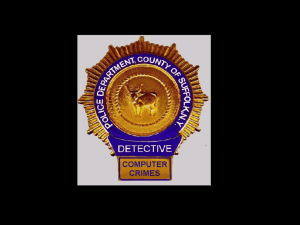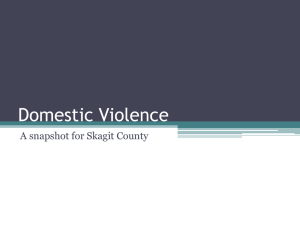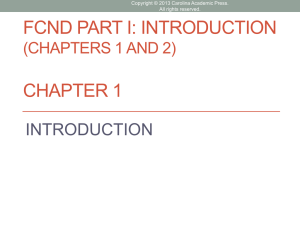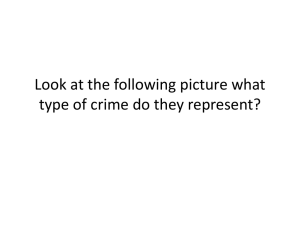powerpoint
advertisement
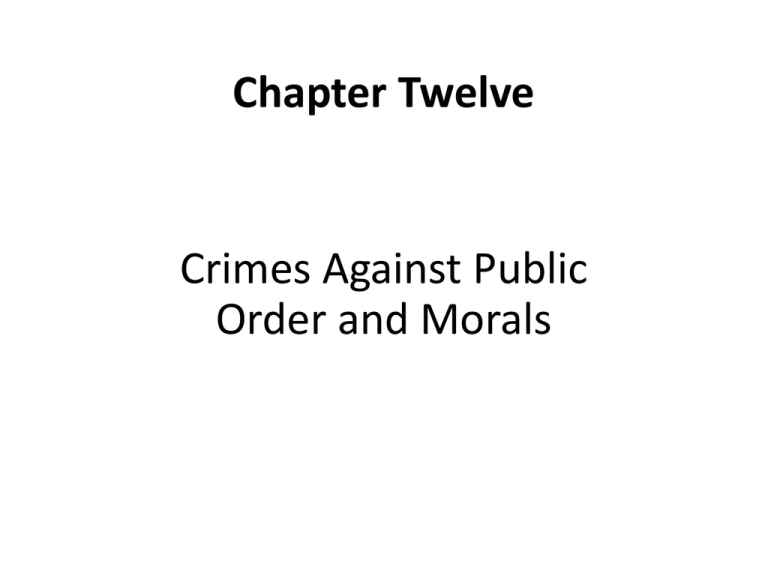
Chapter Twelve Crimes Against Public Order and Morals Chapter Twelve Learning Objectives • To understand how disorderly conduct crimes (quality of life crimes) are aimed at bad manners in public. • To know how efforts to control bad manners in public underscore the tension between order and liberty in constitutional democracies. • To understand that the broken windows theory claims that quality of life crimes are linked to serious crime. Learning Objectives • To appreciate that the widespread consensus among all classes, races, and communities that “street people’s” and “street gangs’” bad behavior should be controlled has shaped the content of the criminal law. • To understand how most people are more worried about bad public manners than they are about serious crimes. • To know how “victimless” crimes against public decency are a hot-button issue between those who believe that criminal law should enforce morality and those who believe the nonviolent behavior of competent adults is none of the law’s business. Disorderly conduct crimes • Crimes against public order and morals • Minor crimes, minor punishment • Important – Represent large portion of criminal justice system – Affect large number of defendants – Influence view of public justice by citizenry Disorderly conduct crimes (continued) • Individual: – Actual disorderly conduct • Fighting in public, making unreasonable noise – Constructive disorderly conduct • Conduct that tends to provoke or excite others to break the peace Disorderly conduct crimes (continued) • Group disorderly conduct – Common law • Unlawful assembly – Group of at least three persons joined for the purpose of committing an unlawful act • Rout – If individuals in the unlawful assembly took action toward achieving the unlawful purpose • Riot – If group committed an unlawful violent act or performed a lawful act in a violent or tumultuous manner Disorderly conduct crimes (continued) • Modern group disorderly conduct – Riot still exists – Riot is a felony under modern law Quality-of-life crimes • Crimes of bad manners in public • People across broad social settings believe that bad public manners create disorder and threaten the quality of life of ordinary people – Others believe that making bad manners against the law, denies the individual’s liberty without due process • Petty crimes aren’t just bothering law-abiding citizens (Wilson and Kelling)… Broken Windows Theory Research • Wilson and Kelling: – Bad manner crimes are connected to serious crime • Kelling: – demonstrated a direct link between disorder and crime • Scogan: – neighborhood levels of disorder are closely related to crime, to fear of crime, and belief that serious crime is a neighborhood problem • Harcourt: – weak to no causal link between disorder and serious crime • Sampson and Raudenbush: – disorder and serious crimes have common causes, but they don’t cause each other—at least not directly Quality of Life Crimes (continued) • In high and low crime cities alike, public drinking and loitering youth top the list of worries among all classes, races, and ethnic groups • People are more concerned about quality of life crime than serious crime Quality of life crimes (continued) • In response to citizen concern about quality of life crimes, legislatures have passed variety of laws (for centuries) • Vagrancy – Roaming about without visible means of support • Loitering – Standing around without no apparent purpose Vagrancy and Loitering Laws • Ancient laws • Trends in these laws follow societal circumstances (Great Depression) – courts striking down laws as unconstitutional starting in the 1940s – Striking down these laws in 1960s and 1970s • Unfairly discriminating against the poor • Papichristou v. City of Jacksonville (1972) – Struck down vagrancy law as unconstitutional Vagrancy and Loitering Laws (continued) • Kolender v. Lawson (1983) – Court imposed constitutional restrictions on loitering laws – Struck down statute for wandering the streets and failing to produce credible identification – 1980s gave rise to new concerns about quality of life crimes which led to new codes and ordinances • Many states included provisions which dealt directly with homelessness Vagrancy and loitering laws (continued) • Discussions of these laws and societal problems highlight the natural tension between order and liberty – Order = acting according to ordinary people’s standards of good manners – Liberty = right of individuals to come and go as they please without interference Vagrancy and loitering laws (continued) • Laws seen as attack on poor and weakest members of society for convenience of wealthy • On other hand, as number of vagrants, loiterers, etc “increased arithmetically, the worrisome behaviors increased geometrically” Joyce v. City and County of San Francisco (1994) Summary of case holding • Preliminary injunctions are extraordinary relief and must be granted sparingly • Injunctions requested (by the homeless to stop enforcement of the Matrix program) can’t be granted because they lack the necessary specificity to be enforceable and the plaintiffs haven’t established the probability of success on the merits (if they were to sue) – Aren’t able to show denial of equal protection and that the intent of the government is to discriminate and haven’t been able to show that police violated due process in implementing the law Panhandling • Stopping people on the street to ask them for food or money • Laws against panhandling are not applied equally to individuals as to charities • Involves free speech protections Panhandling (continued) • Court has created tests to determine whether free speech is being violated • Where speech takes place – Traditional public forums, non public forums, designated public forums (streets, sidewalks and parks) • Reasonable time, place, and manner restrictions – Can’t be based on content of the speech – Must serve a governmental interest (such as maintaining flow of traffic) – Must leave open other channels of expression • Commercial speech (panhandling) has less protection than other types of speech Gresham v. Peterson (2000) Summary of case holding • Court denied Peterson’s petition for injunction limiting the enforcement of the statute banning aggressive panhandling. • Statute was not unconstitutionally vague • Time, manner, and place restrictions were content neutral (if statute narrowly construed), were tied to state’s legitimate interest, and allowed for adequate alternatives to Peterson to engage in asking for money. Gang Activities • Criminal Law Responses to Gang Activity – Statutes criminalizing participation in gangs – Statutes imposing stiffer penalties for crimes committed by gang members – Criminalizing behavior encouraging minors to join gangs – Applying organized crime statutes to gangs. – Statutes punishing parents for their children’s gang activities – Ordinances banning gang members from certain places City of Chicago v. Morales (1999) Summary of case holding • Court struck down the law as too broad and too vague. • It indicated that statutes could address the gang behavior it wanted to address, but that this statute was not drafted in such a way that it met constitutional muster (due process issues…void for vagueness). • Too much discretion for the police, too little notice to the citizenry Gang Activity • Civil Law Responses to Gang Activity – Public nuisance injunctions – E.g., People ex rel. Gallo v. Acuna (1997) – Civil Gang injunctions • Noncriminal lawsuits brought by cities seeking restraining orders to bar gang members from gang activities which can include, interacting with one another, entering specific sections of the city and wearing gang colors • Research – Maxson, Hennigan and Sloan: positive evidence of short term effects in the targeted area but no significant changes in intermediate or long term outcomes – Grogger: in the first year after the injunctions, violent crime decreased Victimless Crimes • Definition for this text – Crimes committed by consenting adults (minors are not included in definition) who do not see themselves as victims of their behavior • Controversy • Public Policy v. Individual Privacy • Rift between those who believe criminal law should enforce morals and those who believe these behaviors are none of criminal law’s business Prostitution and Solicitation • Prostitution – Historically reserved for the act of selling sexual intercourse for money (not buying) – Modern • • • • Buyers and sellers Men and women Soliciting prostitution treated as and defined as prostitution Pimping, pandering, providing place for prostitution included – Misdemeanor offenses generally (unless violence involved)

